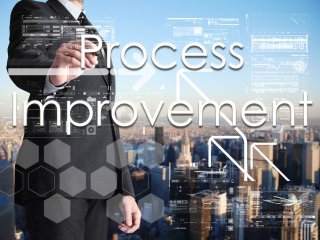
- Description
- Objectives
- Outline
- Materials
- Certification
- System Requirements
- Watch a Demo
Looking for ways to make your company great, motivate your employees, and grow profits? Then Lean Business Management is the program for you. In the first part of this course you will learn Management issues are fundamental to any organization and then moves on to step by step guides for integrating Six Sigma quality management principles to achieve significant gains in quality, productivity, and sales in today's business climate.
Business Management
After completing this course, you should be able to:
- Recognize the various roles of managers and types of business management
- Identify the fundamentals of managing and organizing environments
- Recall methods of communication, working in groups, and stages of leadership
- Discuss the basics of entrepreneurship and SWOT analysis
- Differentiate between multiple leadership styles and ways of managing individuals
Six Sigma Black Belt
After completing this course, you should be able to:
- List the steps for recognizing opportunity in order to build a solid Six Sigma infrastructure
- Define the principles of Six Sigma
- Identify methods for managing metrics
- Name the steps involved in each phase of the Six Sigma development process
- Recall the process behavior charts that can be utilized
Business Management
Business Management Module 1
Managerial Decision Making
- What Do Managers Do?
- The Roles Managers Play
- Major Management Characteristics
- Overview of Managerial Decision Making
- Reflective and Reactive Systems
- Programmed and Nonprogrammed Decisions
- Barriers to Effective Decision Making
- Improving the Quality of Decision Making
- Group Decision Making
Business Management Module 2
The History of Management
- The Early Origins of Management
- The Italian Renaissance
- The Industrial Revolution
- Taylor-Made Management
- Administrative and Bureaucratic Management
- Human Relations Movement
- Contingency and System Management
Business Management Module 3
Corporate Culture and Ethics
- Organization’s External Environment
- External Environments and Industries
- Organizational Designs and Structures
- Internal Organization and External Environments
- Corporate Cultures
- Ethics and Business Ethics Defined
- Dimensions of Ethics
- Ethical Principles and Responsible Decision Making
- Leadership
- Corporate Culture and Compliance
- Corporate Social Responsibility
Business Management Module 4
International Management
- Importance of International Management
- Hofstede’s Cultural Framework
- The GLOBE Framework
- Cultural Stereotyping
- Cross-Cultural Assignments
- Strategies for Expanding Globally
- Necessity of Global Markets
Business Management Module 5
Entrepreneurship
- Characteristics of Successful Entrepreneurs
- Small Business
- Start Your Own Business
- Managing a Small Business
- Large Impact of Small Business
- Small Business Administration
- Trends in Entrepreneurship and Business Ownership
Business Management Module 6
Strategic Analysis
- Understanding the Competitive Environment
- SWOT for Strategic Analysis
- External Macro Environment
- Micro Environment
- Competition, Strategy, and Competitive Advantage
- Strategic Positioning
Business Management Module 7
Strategic Management Process
- Firm Mission and Vision
- The Role of Strategic Analysis in Formulating a Strategy
- Strategic Objectives
- Levels of Strategy
- Measuring and Evaluating Strategic Performance
- Organizational Structures and Design
- Organizational Change
- Managing Change
Business Management Module 8
Human Resource Management
- Human Resource Management and Compliance
- Performance Management
- Influencing Employee Performance and Motivation
- Building an Organization for the Future
- Talent Development
- Succession Planning
Business Management Module 9
Diversity in Organizations
- Introduction to Workplace Diversity
- Diversity and the Workforce
- Diversity and Its Impact on Companies
- Challenges of Diversity
- Key Diversity Theories
- Benefits and Challenges of Workplace Diversity
- Recommendations for Managing Diversity
Business Management Module 10
Leadership and Motivation
- The Leadership Process
- Types of Leaders
- The Trait Approach to Leadership
- Behavioral Approaches to Leadership
- Situational Approaches to Leadership
- Work Motivation for Performance
- Content and Process Theories of Motivation
- Research on Motivation Theories
Business Management Module 11
Managerial Communication and Teamwork
- Teamwork in the Workplace
- Team Development Over Time
- Opportunities and Challenges to Team Building
- Team Diversity
- Multicultural Teams
- Process of Managerial Communication
- Types of Communications in Organizations
- Managerial Communication and Corporate Reputation
Business Management Module 12
Planning, Controlling, and Management of Technology
- The Planning Process
- Types of Plans
- Goals or Outcome Statements
- Employees’ Responses to Planning
- Management by Objectives
- Developing Technology and Innovation
- External and Internal Sources
- Management Entrepreneurship Skills
**Outlines are subject to change, as courses and materials are updated.**
Six Sigma Black Belt
Six Sigma Black Belt Module 1
The Responsive Six Sigma Organization
- What is Six Sigma?
- Six Sigma Philosophy
- Change Imperative
- Implementing Six Sigma
- Timetable
- Infrastructure
- Recognizing Opportunity
- Methods for Collecting Customer Data
- Becoming a Customer and Market-Driven Enterprise
- Quality Function Deployment
- Benchmarking
- Constraint Management Measurements
Six Sigma Black Belt Module 2
Data-Driven Management and Maximizing Resources
- Attributes of Good Metrics
- The Balanced Scorecard
- Customer Perspective
- Internal Process Perspective
- Innovation and Learning Perspective
- Financial Perspective
- Strategy Deployment Plan
- Business Planning
- Data Mining
- Choosing the Right Projects
- Analyzing Project Candidates
- Ongoing Management Support
- Individual Barriers to Change
- Throughput-Based Project Selection
- Ongoing Management Support
Six Sigma Black Belt Module 3
Project Management and Define Phase
- DMAIC and DMADV Deployment Models
- Project Scheduling
- Project Reporting & Budgets
- Six Sigma Teams
- Stages in Group Development
- Member Roles and Responsibilities
- The Define Phase
- Project Charters
- Project Decomposition
- Deliverables
- Top-Level Process Definition
- Assembling the Team
Six Sigma Black Belt Module 4
Measure Phase and Process Behavior Charts
- Process Definition
- Metric Definition
- Process Baseline Estimates
- Control Charts for Variables Data
- Poisson Distribution
- Frequency and Cumulative Distributions
- Sampling Distributions
- Binomial Probability Distribution
- Hypergeometric Probability Calculations
- Normal Probability
- Lognormal Probability
- Exponential Probability
- Control Charts for Variables Data
- Control Limit Equations for Averages and Ranges Charts
Six Sigma Black Belt Module 5
Measurement Systems Evaluation and Analyze Phase
- Definitions
- Measurement System Discrimination
- Stability
- Repeatability
- Linearity
- Output
- Value Stream Analysis
- Value Stream Mapping
- Spaghetti Charts
- Analyzing the Source of Variation
- Cause and Effect Diagrams
- Boxplots
- Regression and Correlation Analysis
Six Sigma Black Belt Module 6
Improve/Design and Control/Verify Phases
- Using Customer Demands to Make Decisions
- Lean Techniques for Optimizing Flow
- Using Empirical Model Building to Optimize
- Data Mining
- Artificial Neural Networks
- Virtual Process Mapping
- Optimization Using Simulation
- Risk Assessment Tools
- Failure Mode and Effect Analysis
- Defining New Performance Standards Using Statistical Tolerancing
- Validating the New Process or Product Design
- Business Process Control Planning
**Outlines are subject to change, as courses and materials are updated.**
All course materials included.
Six Sigma Black Belt
Upon successful completion of this course, students will be prepared to sit for the American Society for Quality Six Sigma Black Belt (CSSBB) certification exam.
Note: This course is not affiliated with, nor has it been endorsed by ASQ.
Internet Connection
- Broadband or High-Speed - DSL, Cable, and Wireless Connections
*Dial-Up internet connections will result in a diminished online experience. Classroom pages may load slowly and viewing large audio and video files may not be possible.
Hardware Requirements
- Processor - 2GHz Processor or Higher
- Memory - 1 GB RAM Minimum Recommended
PC Software Requirements
- Operating Systems - Windows 7 or higher
- Microsoft Office 2013 or higher. Also, you could use a general Word Processing application to save and open Microsoft Office formats (.doc, .docx, .xls, .xlsx, .ppt, .pptx)
- Internet Browsers - Google Chrome is highly recommended
- Cookies MUST be enabled
- Pop-ups MUST be allowed (Pop-up Blocker disabled)
- The Kindle Reader App or VitalSource Bookshelf App are needed for many of our courses (No special equipment needed. This can be downloaded for FREE onto your computer.)
- PowerPoint Viewer (if you do not have PowerPoint)
- Adobe PDF Reader
- QuickTime, Windows Media Player &/or Real Player
MAC Software Requirements
- Operating Systems - Mac OS x 10 or higher with Windows
- Mac office programs or a Word Processing application to save and open Microsoft Office formats (.doc, .docx, .xls, .xlsx, .ppt, .pptx)
- Internet Browsers- Google Chrome is highly recommended
- Cookies MUST be enabled
- Pop-ups MUST be allowed (Pop-up Blocker disabled)
- The Kindle Reader App or VitalSource Bookshelf App are needed for many of our courses (No special equipment needed. This can be downloaded for FREE onto your computer.)
- PowerPoint Viewer (if you do not have PowerPoint)
- Adobe PDF Reader
- Apple QuickTime Media Player
